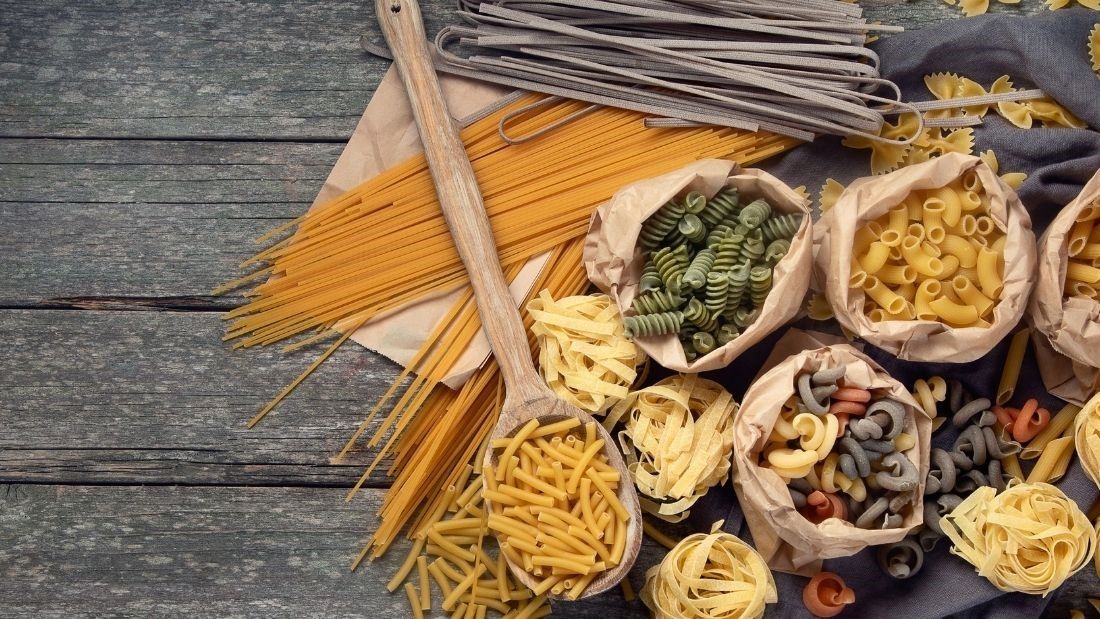Pasta

Pasta and similar foods have been around for hundreds, if not thousands, of years and it’s not surprising that they’ve endured with their versatility, affordability and ease of cooking. But people are divided on whether or not pasta can be considered a healthy food.
Is pasta healthy?
Traditionally seen as a no-go for anyone trying to lose excess weight, lots of people avoid pasta. Weight Watchers even created a range of ‘skinny’ pasta, made from a tuber-like starchy corm called konjac, which has only nine calories per serving and works by swelling up in the stomach to make you feel full.
Pasta can, however, form part of a healthy diet and is one of the most affordable sources of carbohydrate – important to ensure that our bodies have the energy needed to function. We tend to think of energy from food being needed to help us move around, exercise and concentrate, but every single cell in our body needs it to perform hundreds of chemical reactions and processes that are constantly going on in the background. Our brains alone use around 20 per cent of our energy when we’re resting – and that’s just one organ!
Pasta can even be a good food to incorporate for those trying to lose excess weight. It’s very filling, so can curb your desire to snack on less healthy foods, and reduce your total calorific intake for the day.
Much of pasta’s bad reputation can be attributed to two factors – portion size and the sauce it’s served with. Avoid heavy, creamy sauces and replace cheese with nutritional yeast – a rich source of B vitamins.
The healthiest way to enjoy pasta
If you’re one of those who adore pasta and eat it regularly, there are many ways to make your dishes healthier and more nutritious. The main culprit for making pasta dishes unhealthy is ready-made sauces, which often contain a lot of sugar and salt. Even though the tomato content may contribute to your 5-a-day, there are much better options, such as making your own sauce. You can control how much sugar and salt it contains, and can add plenty of vegetables and pulses.
For a really quick sauce, gently steam or fry onions, peppers, mushrooms, courgettes or any other veg you fancy, toss them into a pan with some homemade passata (really easy to make), dried herbs, such as basil or oregano, chopped garlic and tinned beans – kidney or borlotti work well). Add some spinach at the end, mix in your cooked pasta and hey presto!
Another key to making healthy pasta dishes is to avoid making the pasta a main focus – think of it as a vegetable or bean dish, accompanied by a small portion of pasta. Most pasta dishes also go well with a side salad, which will help to boost your veg intake even more!
Different types of pasta
Another way to make pasta dishes healthier is to opt for wholewheat rather than ‘white’ pasta. Wholegrain pasta is a good source of healthy carbohydrates (sugars) and contains more protein, fibre, vitamins and minerals than white pasta.
Other options include the huge variety of pulse or legume-based pasta now available, including edamame, lentil and chickpea varieties, which can even provide one portion of your 5-a-day! Coloured pasta is often seen as a healthier option but even though the colouring is from vegetables such as spinach, tomato and beetroot, the amounts involved are minimal and provide little benefit.
| Type of pasta | Protein (per 100g) | Fibre (per 100g) |
| Black Bean Spaghetti | 45.3 | 19.6 |
| Edamame Spaghetti | 42.2 | 23.3 |
| Red Lentil Penne | 20.6 | 6.0 |
| Chickpea Fusilli | 20.0 | 14.0 |
| Wholewheat Fusilli | 13.0 | 8.0 |
| Tricolore Fusilli | 14.0 | 3.0 |
| White Penne | 4.9 | 2.7 |
Sugar rush
The high carbohydrate (sugar) content of traditional white pasta causes a spike in blood sugar levels shortly after eating. Foods that produce this effect are known as high glycaemic index (GI) foods and can cause problems for people with diabetes, who need to maintain their blood sugar at a normal and consistent level. Interestingly, cooling pasta before you eat it can lower the GI and some research even suggests that this effect is increased further when the cooled pasta is then reheated!
This process of cooking and cooling causes the structure of the carbohydrate to change into a form that is harder for our bodies to use. It’s called resistant starch and it effectively becomes a type of fibre that doesn’t affect blood sugar so dramatically and has the added benefit of providing your gut bacteria with an energy source.
Providing gut bacteria with resistant starch and other types of fibre encourages them to produce short-chain fatty acids. These provide the cells of the bowel with a source of energy which helps to protect against bowel cancer.
Final word
Pasta doesn’t automatically mean weight gain. It can provide a perfect canvas to build a healthy and balanced dish around, especially if you make your own sauce and add lots of vegetables, pulses and legumes. Be aware of the recommended portion sizes and try some of the more interesting pasta varieties to add a boost of healthy goodness to your dish!




